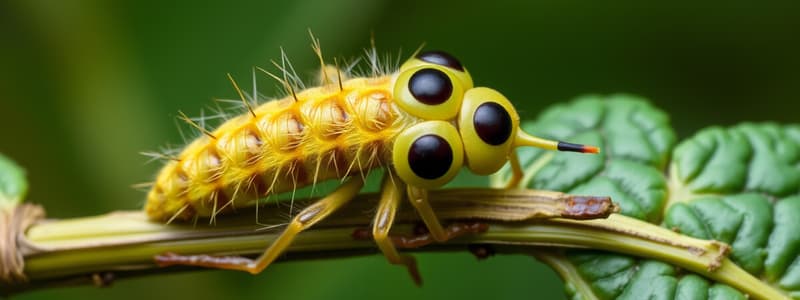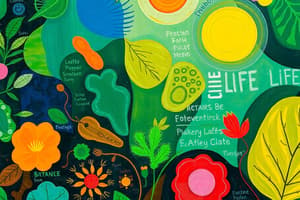Podcast
Questions and Answers
What is the definition of an organism?
What is the definition of an organism?
An organized, genetic unit capable of metabolism, reproduction, and evolution.
Which of the following are characteristics of a living organism? (Select all that apply)
Which of the following are characteristics of a living organism? (Select all that apply)
- Contain genetic information (correct)
- Use genetic information to reproduce themselves (correct)
- Can fly
- Consist of 1 or more cells (correct)
What does metabolism refer to?
What does metabolism refer to?
An organism's total chemical activity.
What is homeostasis?
What is homeostasis?
What does the Cell Theory state?
What does the Cell Theory state?
How do living things evolve according to Natural Selection?
How do living things evolve according to Natural Selection?
What is a Species Concept?
What is a Species Concept?
Who is Alfred Russel Wallace?
Who is Alfred Russel Wallace?
What is adaptation?
What is adaptation?
What are the 3 factors necessary for natural selection?
What are the 3 factors necessary for natural selection?
What is a mutation?
What is a mutation?
What does heritability refer to?
What does heritability refer to?
What is evolution?
What is evolution?
Which of the following are considered evidence of evolution? (Select all that apply)
Which of the following are considered evidence of evolution? (Select all that apply)
What is a genome?
What is a genome?
What is DNA's role?
What is DNA's role?
What is a nucleotide?
What is a nucleotide?
What is a gene?
What is a gene?
What is synthesis in biological terms?
What is synthesis in biological terms?
Define extracellular fluids.
Define extracellular fluids.
Match the following levels of organizational hierarchy of cells:
Match the following levels of organizational hierarchy of cells:
What is a community in biological terms?
What is a community in biological terms?
Define an ecosystem.
Define an ecosystem.
What is the biosphere?
What is the biosphere?
What are the consequences of photosynthesis? (Select all that apply)
What are the consequences of photosynthesis? (Select all that apply)
What is the Endosymbiotic Theory?
What is the Endosymbiotic Theory?
What is an organelle?
What is an organelle?
What are the 2 developments that made multicellular organisms possible? (Select all that apply)
What are the 2 developments that made multicellular organisms possible? (Select all that apply)
What are the three domains of life?
What are the three domains of life?
What are protists?
What are protists?
Multicellular eukarya evolved from __________.
Multicellular eukarya evolved from __________.
The scientific method or __________.
The scientific method or __________.
What are the 5 steps to the Hypothesis-Prediction Method? (Select all that apply)
What are the 5 steps to the Hypothesis-Prediction Method? (Select all that apply)
What is inductive logic?
What is inductive logic?
What is deductive logic?
What is deductive logic?
What is a theory in scientific terms?
What is a theory in scientific terms?
Which of the following are ways to test a hypothesis? (Select all that apply)
Which of the following are ways to test a hypothesis? (Select all that apply)
What are comparative studies?
What are comparative studies?
What is a controlled experiment?
What is a controlled experiment?
What is an independent variable?
What is an independent variable?
What is a dependent variable?
What is a dependent variable?
Flashcards are hidden until you start studying
Study Notes
Organisms and Life Characteristics
- Organisms are organized genetic units with capabilities for metabolism, reproduction, and evolution, descending from a single-celled ancestor.
- Seven characteristics defining living organisms: single or multiple cells, genetic information, ability to reproduce, genetic relation and evolution, conversion of environmental molecules into biological molecules, energy extraction for biological work, and internal regulation.
Biological Processes
- Metabolism encompasses all chemical activities of an organism, involving energy extraction and molecule conversion.
- Homeostasis refers to the maintenance of stable internal conditions necessary for survival.
Cell Theory and Evolution
- Cell Theory states all cells arise from preexisting cells, share similar chemical compositions, perform most life processes, and replicate complete genetic information during division.
- Biological evolution, or natural selection, describes the process where living organisms evolve through differential survival and reproduction.
Species and Adaptation
- The Species Concept defines a group of morphologically similar organisms capable of interbreeding.
- Adaptation refers to inherited traits that enhance survival and reproduction in a specific environment.
Natural Selection Factors
- Three necessary factors for natural selection: individual variation within populations, differential reproductive success, and heritability of traits.
Genetic Concepts
- Mutations refer to changes in an organism's genetic material affecting evolution and heritability.
- Heritability denotes adaptations that are genetically controlled and passed on to future generations.
- Evolution is described as the change in genetic makeup of a population over generations.
Evidence for Evolution
- Evidence includes insect and antibiotic resistance, as well as industrial melanism observed in peppered moths.
Genetics and Molecular Biology
- A genome is the complete set of DNA within a cell, with all cells in a multicellular organism sharing the same genome.
- DNA conveys genetic information from parent to daughter cells through nucleotide sequences, which are the building blocks of nucleic acids.
Biological Organization and Community
- Organizational hierarchy: atoms, molecules, cells, tissues, organs, organisms, populations, communities, ecosystems, biosphere.
- A community consists of interacting populations of different species, while an ecosystem encompasses interacting communities.
Photosynthesis Impact
- Photosynthesis led to atmospheric oxygen accumulation, the onset of aerobic metabolism, and formation of the ozone layer enabling terrestrial life.
Endosymbiotic Theory
- Suggests the evolution of eukaryotic cells from prokaryotic cells that engulfed smaller cells, leading to symbiotic relationships.
Biological Structures and Cells
- Organelles are specialized structures within cells that perform distinct functions.
- Multicellularity arose due to cell specialization and the ability of cells to adapt to environmental challenges.
Domains of Life
- Three domains of life: Bacteria, Eukarya, and Archaea, with protists being unicellular eukaryotic organisms.
Scientific Methodology
- The scientific method, also known as the hypothesis-prediction method, involves steps: observation, questions, hypothesis formation, predictions, and testing.
- Inductive logic derives general conclusions from specific observations, while deductive logic applies general principles to reach specific outcomes.
Theories and Testing Hypotheses
- A scientific theory emerges from ongoing support for a hypothesis through consistent testing.
- Two approaches to test a hypothesis include comparative studies (analyzing natural group differences) and controlled experiments (manipulating variables while maintaining constants).
Variables in Experiments
- Independent variables are those manipulated to observe effects, whereas dependent variables represent the measured outcomes or responses.
Studying That Suits You
Use AI to generate personalized quizzes and flashcards to suit your learning preferences.




